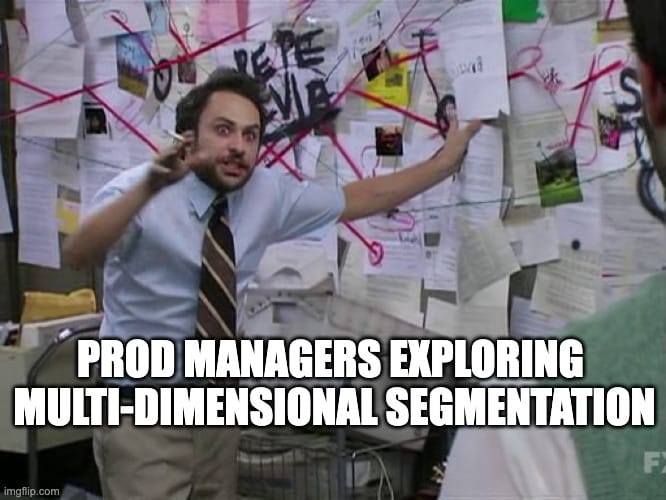How to Segment Users in a Mobile Gaming App?
Contents

What is Segmentation?
Player preferences, behaviors, and motivations can vary significantly and this is where the segmentation comes into play. User segmentation is a crucial strategy in mobile gaming, involving the division of your player base into distinct groups based on shared characteristics. This process allows gaming studios to tailor in-game experiences, marketing efforts, and game content to meet the specific needs and preferences of each group, enhancing overall user monetization and retention.
The Role of Segmentation in Mobile Gaming
Implementing an effective segmentation strategy is pivotal for mobile game studios seeking to unlock the full potential of their user base. By identifying and catering to the specific preferences and behaviors of different player segments, developers can unlock a myriad of benefits that directly contribute to the overall success of their gaming endeavors.
Personalized Experiences: The Key to Engagement
One of the primary advantages of segmentation is the ability to craft personalized experiences that captivate and engage players on a deeper level. By understanding the nuances of each segment's preferences, game developers and product managers can tailor in-game content, advertising, and promotional offers to align with their target audience's interests and expectations. This personalized approach not only enhances user satisfaction but also fosters a stronger emotional connection with the game, ultimately leading to increased engagement and retention.
Maximizing Monetization Potential
Segmentation also plays a crucial role in optimizing monetization strategies within mobile gaming apps. By identifying segments of players who are more inclined to make in-app purchases or engage with specific monetization models, developers can strategically allocate resources and tailor their offerings accordingly. This targeted approach not only increases the likelihood of conversion but also ensures that marketing efforts and promotional campaigns are directed towards the most receptive segments, resulting in a higher return on investment.
Data-Driven Decision Making
Effective segmentation relies heavily on the collection and analysis of user data, enabling developers to make informed decisions based on factual insights. By leveraging advanced game analytics tools and tracking user behaviors, preferences, and interactions within the game, developers and product managers can continuously refine and optimize their segmentation strategies, ensuring that they remain relevant and aligned with the evolving needs of their players.
Types of Segmentation: Tailoring Experiences for Every Player
The art of segmentation encompasses various approaches, each designed to cater to specific aspects of user behavior and preferences. By understanding and implementing these diverse segmentation techniques, mobile game studios can unlock a world of opportunities to enhance user engagement, drive monetization, and foster long-term loyalty among their player base.
Demographic Segmentation
Demographic segmentation is a foundational approach that involves categorizing users based on characteristics such as age, gender, location, device and income level. This technique enables developers to tailor their marketing efforts, in-game content, and promotional offers to resonate with specific demographic groups, ensuring that the gaming experience aligns with their cultural and societal preferences.
Segment Type Use Case:
Age: Different age groups may have varying preferences and gaming habits which helps you tailor in-game events or promotions to appeal to specific age groups.
Gender: Understanding the gender distribution can help in designing more inclusive game features. This enables you to create gender-neutral marketing campaigns or specific promotions.
Location: Segmenting users by geographical location and localize in-game content and promotions to suit regional preferences.
Psychographic Segmentation
While demographic segmentation focuses on tangible characteristics, psychographic segmentation delves deeper into the psychological and behavioral traits of users. By analyzing factors such as personality types, lifestyle preferences, values, and interests, game studios can gain valuable insights into the motivations and drivers that influence player engagement and decision-making within the gaming environment.
Segment Type Use Case:
Interests: For larger studios, you can segment users based on their preferred game genres (e.g., puzzle games, strategy games). Develop game content that aligns with the interests of specific psychographic groups.
Values and Lifestyle: Segment as per casual gamers vs hardcore gamers and offer different in-game events catering to casual and hardcore players.
In-Game Behavior Segmentation
One of the most powerful segmentation techniques in the mobile gaming universe is in-game behavior segmentation. By tracking and analyzing user interactions, gameplay patterns, and in-app actions, developers can identify distinct segments based on factors such as gameplay style, progression rate, and monetization preferences. This approach enables the creation of highly personalized experiences tailored to specific player behaviors, fostering increased engagement and retention.
Segment Type Use Case:
Play Frequency: Grouping users based on their frequency of play (daily, weekly, monthly) and offer loyalty rewards to daily players or returning users.
In-Game Purchases: Segmenting based on spending behavior (non-spenders, low spenders, high spenders) can help you provide exclusive offers to high spenders and encourage them to purchase more.
Engagement Level: Identifying highly engaged users versus those who are at risk of churning to implement re-engagement campaigns for users showing signs of churn.
Technographic Segmentation
Technographic segmentation plays a vital role in ensuring that the gaming experience is optimized for different devices, operating systems, and hardware capabilities. By segmenting users based on their technological preferences and capabilities, developers can ensure that the game runs smoothly across various platforms, minimizing frustrations and enhancing overall user satisfaction.
Segment Type Use Case:
Device Type: Differentiate between iOS and Android users, or high-end vs. low-end devices and optimize game performance for various devices to ensure a smooth experience.
Network Connectivity: Segment users based on their connectivity (Wi-Fi vs. mobile data) and adjust game features and download sizes according to connectivity.
Monetization-Based Segmentation
Monetization-based segmentation involves categorizing users based on their spending habits and propensity to make in-app purchases. By identifying segments of high-value spenders (whales), moderate spenders (dolphins), and non-spenders (minnows), developers can tailor their monetization strategies, promotional offers, and in-game economies to maximize revenue potential while maintaining a balanced and engaging experience for all players.
Segment Type Use Case:
Whales: Group high spending users together and work on ways to increase the average revenue per paying user (ARPPU) with special events or offers catered to them.
Dolphins: Segment players as per average value of spends and frequency of spends. From here you can work on increasing their frequency with targetted offers and communication to them.
Multi-Dimensional Segmentation
While each segmentation approach offers distinct advantages, true mastery lies in the ability to combine multiple techniques to create a holistic and comprehensive understanding of the user base. By employing multi-dimensional segmentation, which integrates various factors such as demographics, psychographics, in-game behaviors, and monetization patterns, game studios and product managers can unlock a plethora of insights and create highly targeted experiences that cater to the unique needs and preferences of each player segment.

Conclusion: Unlocking the Path to Mobile Gaming Success
Segmentation is a powerful way for game studios to captivate, monetize and retain their player base. By understanding and implementing the various segmentation techniques, developers and product managers can unlock ample opportunities to create personalized experiences, optimize monetization strategies, and foster long-term engagement and loyalty among their players.
However, successful segmentation is not a one-time endeavor; it requires a continuous commitment to data-driven decision-making, iterative testing, and adaptation to evolving user preferences. As the mobile gaming industry continues to evolve, those who master segmentation will undoubtedly gain a competitive edge, engaging players with tailored experiences that resonate on a deeper level.
